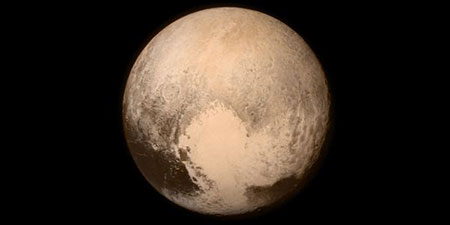
FROM HEAVEN TO EARTH
THE HEART OF PLUTO!
A DAY NOT FAR THIS LITTLE PLANET OF YOUR SOLAR SYSTEM WILL HOST LIFE IN ALL ITS FINEST THREE-DIMENSIONAL MANIFESTATIONS: MINERAL, VEGETABLE, ANIMAL-HUMAN.
THE LITTE-BIG SUN, JUPITER (ZEUS), WILL AWAKEN FROM ITS LONG APPARENT SLEEP AND WILL GIVE LIFE AND PROSPERITY TO THE DISTANT PLANETS, PLUTO, URANUS, NEPTUNE AND TO THREE OTHERS THAT YOUR SCIENCE HAS NOT RECOGNIZED AS SUCH YET.
ONE DAY, THE NIGHT WILL BE DAY AND THE DAY WILL BE BRIGHTNESS ON EARTH NAMELY WHEN THE INHABITANTS OF THE BLUE PLANET, WHO HAVE INHERITED THE KINGDOM OF CHRIST, WILL FEEL JOY IN THEIR SPIRIT AND HAPPINESS IN THEIR SOUL BECAUSE EVERY SUNRISE AND EVERY SUNSET SHALL ENJOY THE VISION OF TWO SUNS: THE FATHER AND THE SON THAT WILL SHINE WITH HEROIC FURY AND IMMENSE LOVE ON THE SPIRIT, ON THE SOUL AND ON THE BODY OF THE INHABITANTS OF THE EARTH.
THE HEART OF PLUTO IS ANNOUNCER OF THIS TRUTH.
PEACE!
A SOLAR GENIUS.
FROM HEAVEN TO EARTH
Polcenigo -PN (Italy)
July 12th 2015 9 : 32 p.m.
G. B.
NASA?S NEW HORIZONS: A ?HEART? FROM PLUTO AS FLYBY BEGINS
After a more than nine-year, three-billion-mile journey to Pluto, it?s show time for NASA?s New Horizons spacecraft, as the flyby sequence of science observations is officially underway.
In the early morning hours of July 8, mission scientists received this new view of Pluto?the most detailed yet returned by the Long Range Reconnaissance Imager (LORRI) aboard New Horizons. The image was taken on July 7, when the spacecraft was just under 5 million miles (8 million kilometers) from Pluto, and is the first to be received since the July 4 anomaly that sent the spacecraft into safe mode.
This view is centered roughly on the area that will be seen close-up during New Horizons? July 14 closest approach. This side of Pluto is dominated by three broad regions of varying brightness. Most prominent are an elongated dark feature at the equator, informally known as ?the whale,? and a large heart-shaped bright area measuring some 1,200 miles (2,000 kilometers) across on the right. Above those features is a polar region that is intermediate in brightness.
?The next time we see this part of Pluto at closest approach, a portion of this region will be imaged at about 500 times better resolution than we see today,? said Jeff Moore, Geology, Geophysics and Imaging Team Leader of NASA?s Ames Research Center. ?It will be incredible!?
July 8, 2015

https://www.nasa.gov/feature/nasa-s-new-horizons-a-heart-from-pluto-as-flyby-begins








